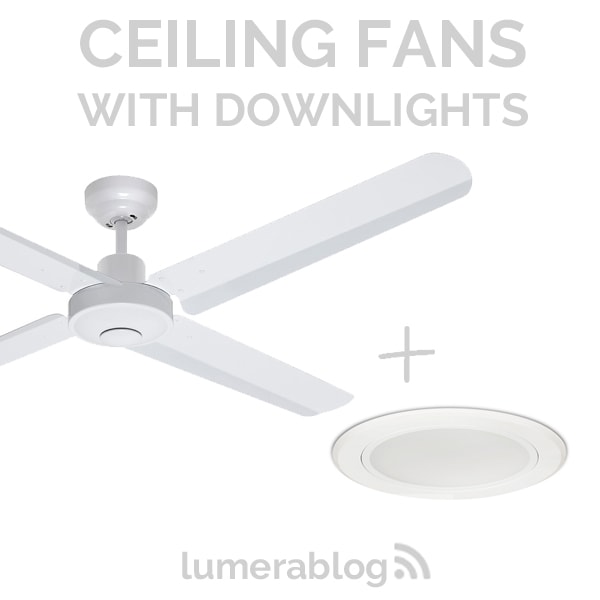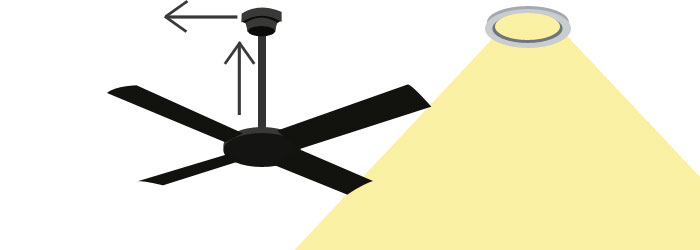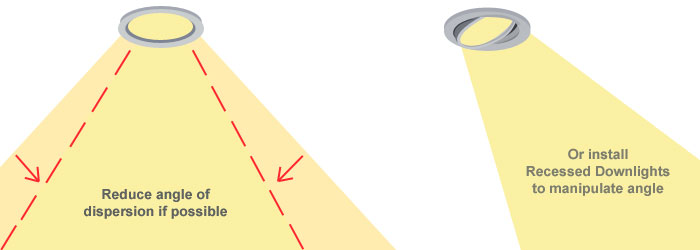Ceiling Fan with Downlights FAQ

Downlights – Will they interfere with my ceiling fan?
If you are looking to install a ceiling fan in a room where downlights are used it is important to be aware that a strobing effect can occur if all elements are not positioned correctly in relation to each other.
Downlights disperse light creating a triangular path called a cone of light. Therefore, it is crucial that the fan is installed in a position in which it does not cross paths with the light as the beams extend outward. A rule of thumb to keep in mind is to aim to have a minimum of 600mm between the edge of the blade and the downlight to minimise the chance of interference.

However, do not take this to be a definitive measurement as accuracy will undoubtedly depend on your space itself and the lights in question. Elements that can affect the distance required include:
The type of lamp being used, as this effect is more likely to occur with fluorescent tubes and bulbs as they are designed to disperse the light as much as possible meanwhile, halogen alternatives cast a slightly more direct path.
The degree of the beam angle will affect the distance and influence the range of ceiling fans you can choose from. For example, downlights with a smaller beam angle (30 and under) may allow for a fan with a wider blade span. Whereas those with larger angles may require a smaller, or low profile fan to be installed. In saying this, the downlight beam angle will generally depend on the height of your ceiling as higher ceilings usually have a narrower beam and vice versa. Keep in mind that the narrower the beam the more downlights you may need to cover the area which can impact ceiling fan installation and selection.
Having a higher than standard ceiling, particularly when an extension rod has to be used is another factor. The lower the fan the higher the chance that the blade will interfere with the spread of the light. See diagram.

If the ceiling fan is closer to the ceiling and further away from the downlight potential interference is minimised. Otherwise, the blades may evade the cone of light as pictured. A shorter extension rod, smaller blade span or low profile fan may need to be considered before installation.
It is important to note as well that the more downlights you have surrounding the fan the more probable that this effect will not be as noticeable if a degree of strobing is unavoidable. Ideally, you will have installed at least four to surround the ceiling fan. However, the number of downlights necessary will vary according to the requirements of the location and how much light you need.
Downlight Placement Indication

Note: Downlights should never be installed too close to the wall (edges of the room), or too far away from the fan otherwise shadows may be created. Neither should the fan overlap with the downlights.
The downlights closest to the wall should generally be placed no less than 60cm into the room as this accounts for the depths of cupboards etc. However, this figure may vary.
Our general recommendations:
If you have a standard ceiling height, you may wish to consider purchasing a low profile ceiling fan. This means that the fan will sit closer to the ceiling and as a result the blades will be higher also. Therefore, they will be less likely to cross the lights path as it disperses downwards and more likely to remain at an appropriate distance.
Alternatively, we do have a selection of smaller fans (under 44”) that you may prefer which will allow you to increase the space between the blades and downlights. This would be ideal for smaller spaces particularly some bedrooms where space can be limited. Most of these fans have an average ceiling to blade drop of 30cm.
Installation Considerations:
If you are yet to install your downlights, contemplate using adjustable recessed downlights, as these will enable you to direct the path at a slight angle away from your ceiling fan and consequently the blades should not directly obstruct the cone of light. The ceiling fan should be placed in the centre with the lights surrounding it. In a smaller space downlights that allow the angle of dispersion to be adjusted will be beneficial if the ceiling height requires a significant drop and extension rods are required as a result.
If the chance of this occurring in your home has you hesitant to install both downlights and a ceiling fan, consider purchasing a ceiling fan with an integrated light, that way your ceiling fan can also be your primary source of lighting.

These diagrams are not scaled representations and should only act as a rough indication of how the layout may look. Please take into account that the above are general recommendations however, several other variables may need to be considered for your location. For specific advice based on your space please contact your electrician directly.
